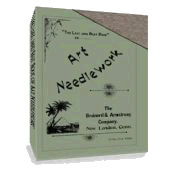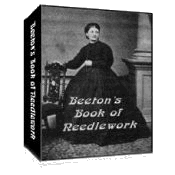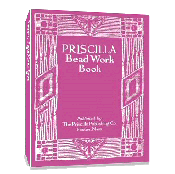CROCHET INSTRUCTIONS
AUTHENTIC VICTORIAN CROCHET INSTRUCTIONS!

Crochet instructions could readily be found by any Victorian woman. The following are excerpts from the popular Beeton's Book of Needlework, a book that many women of the era found extremely useful.
Cotton or thread, wool or silk, with a crochet-needle, are the materials required for working crochet. The needle, whether it be steel or bone, must be smoothly polished. The long wooden and bone crochet-needles are used for wool; for cotton and silk work short steel needles screwed into a bone handle are best. The beauty of the crochet-work depends upon the regularity of the stitches, as is the case with every other style of needlework. The stitches must be elastic, but if too loose they look as bad as if too tight. The size of the needle and that of the cotton or wool must correspond; work only with the point of the needle, and never move the stitch up and down the needle. The cotton with which you work must be of the very best quality; for borders, insertions, rosettes, imitation of guipure, use Evans's crochet cotton; for couvrettes, counterpanes, covers, &c., use knitting-cotton.
General Crochet Instructions
All crochet-work patterns are begun on a foundation chain; there are three kinds of foundation chains - the plain foundation, the double foundation, and the purl foundation chain. The Plain Foundation Chain consists of chain stitches.
The Plain Foundation Chain consists of chain stitches.Form a loop with the cotton or other material with which you work, take it on the needle, and hold the cotton as for knitting on the forefinger and other fingers of the left hand. The crochet-needle is held in the right hand between the thumb and forefinger, as you hold a pen in writing; hold the end of the cotton of the loop between the thumb and forefinger of the left hand, wind the cotton once round the needle by drawing the needle underneath the cotton from left to right, catch the cotton with the hook of the needle and draw it as a loop through the loop already on the needle, which is cast off the needle by this means and forms one chain stitch. The drawing the cotton through the loop is repeated until the foundation chain has acquired sufficient length. When enough chain stitches have been made, take the foundation chain between the thumb and forefinger of the left hand, so that these fingers are always close to and under the hook of the needle. Each stitch must be loose enough to let the hook of the needle pass easily through. All foundation chains are begun with a loop.
 The Double Foundation Chain. - Crochet 2 chain stitches, insert the needle downwards into the left side of the 1st chain stitch, throw the cotton forward, draw it out as a loop, wind the cotton again round the needle and draw it through the two loops on the needle, * draw the cotton as a loop through the left side of the last stitch (see illustration), wind the cotton round the needle, and draw it through both loops on the needle. Repeat from * till the foundation chain is long enough.
The Double Foundation Chain. - Crochet 2 chain stitches, insert the needle downwards into the left side of the 1st chain stitch, throw the cotton forward, draw it out as a loop, wind the cotton again round the needle and draw it through the two loops on the needle, * draw the cotton as a loop through the left side of the last stitch (see illustration), wind the cotton round the needle, and draw it through both loops on the needle. Repeat from * till the foundation chain is long enough.

Slip Stitch. - Draw the needle through the back part of a foundation chain stitch, or in the course of the work through the back part of a stitch of the preceding row, wind the cotton round the needle, and draw it through the stitch and loop on the needle. The illustration shows a number of slip stitches, the last of which is left quite loose; the arrow marks the place where the needle is to be inserted for the next stitch.


Victorian women found crochet instructions in books on homemaking as well as many of the magazines and newspapers of the times. In these same magazines were ads for crochet needles. These could be simple such as a pointed rod made of steel or elaborately designed with ivory and silver. As crocheting was the perfect way for a lady to show off her delicate hands, many crochet needles were purchased for looks rather than utility.
The beauty of crochet instructions is that it did not require fancy needles or expensive cotton thereby allowing ladies of all social standing to beautify their homes with ease and frugality.
If you find the instructions above just a little hard to follow or you feel they are too advanced for you, check out these easy to understand beginner crochet instructions. They'll have you crocheting in no time. If watching a video is more your style, you’ll want to see these crochet videos. You'll be amazed how simple crochet can really be!
Return to top of Crochet Instructions page.
Return to Crochet page.
Return to Home Page.



 433 pages!
433 pages!

